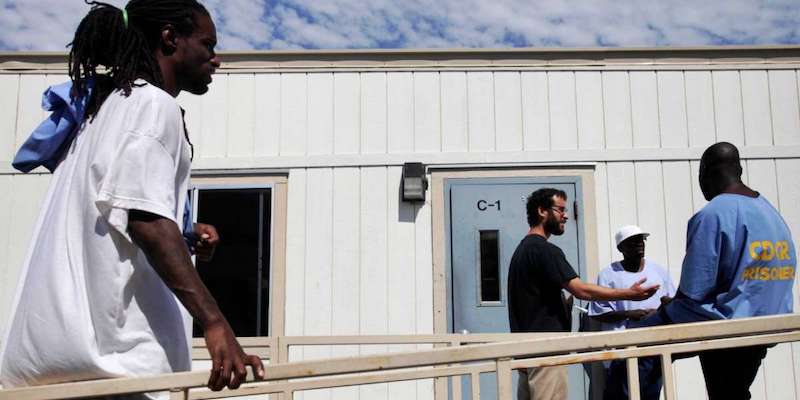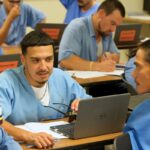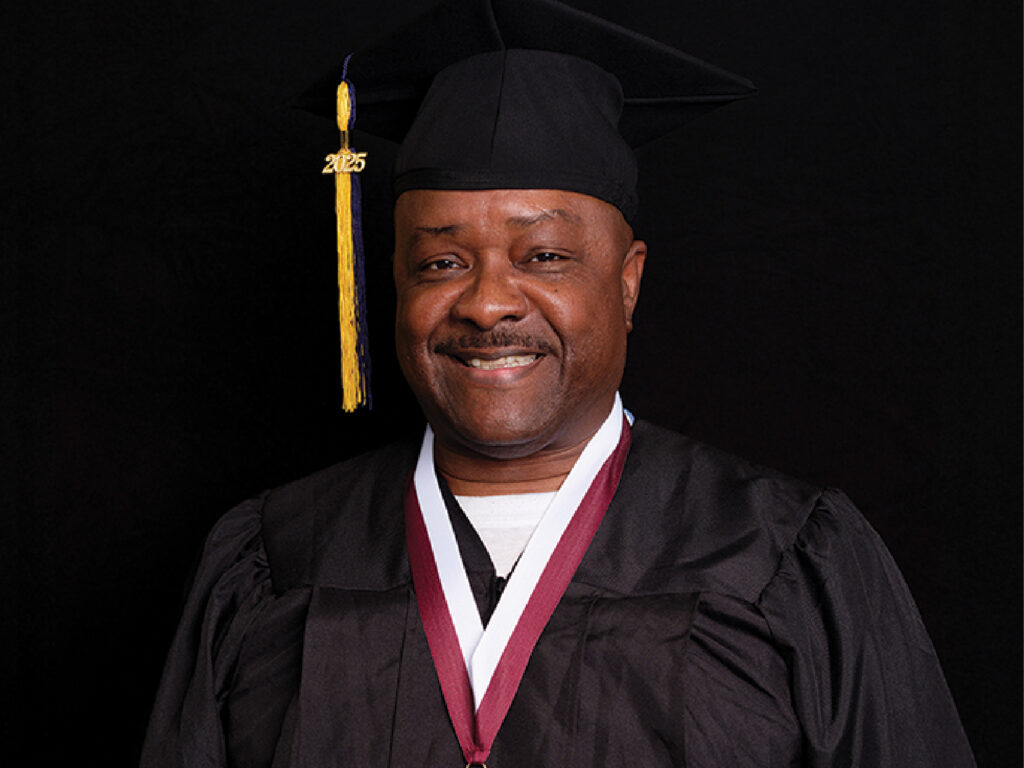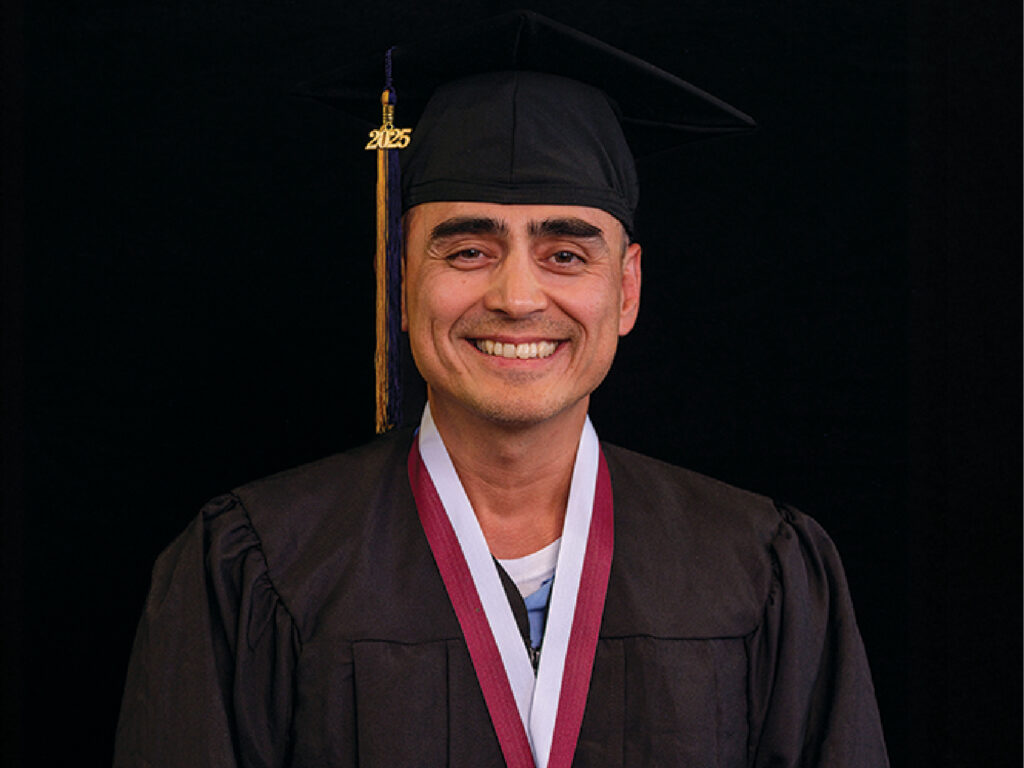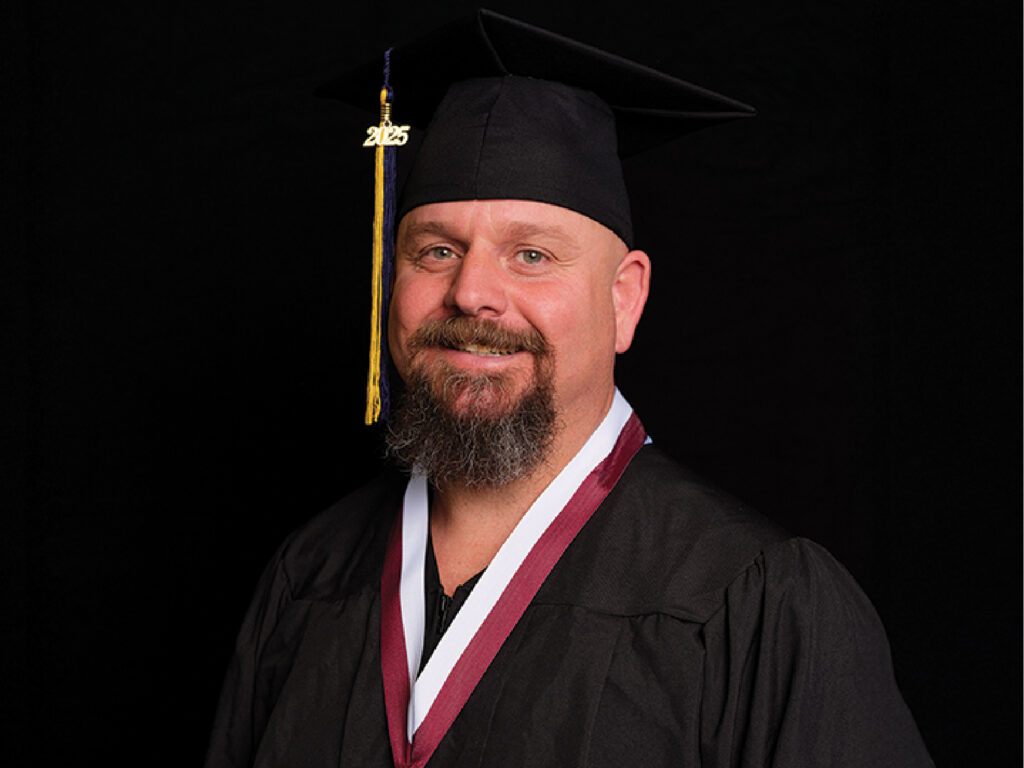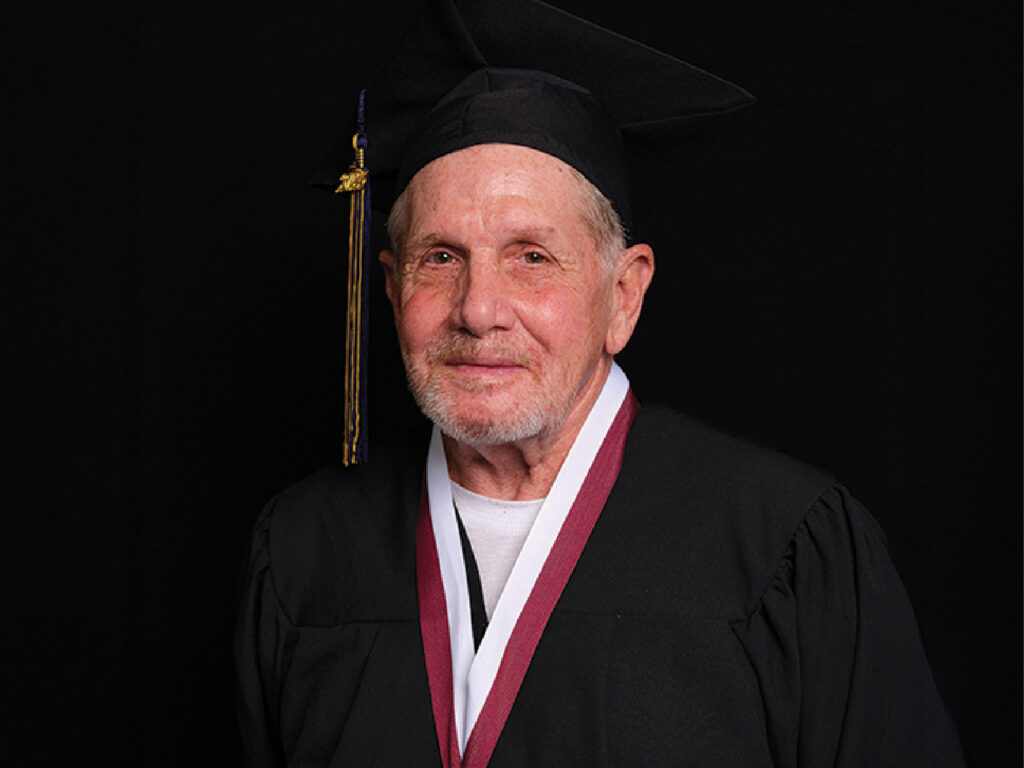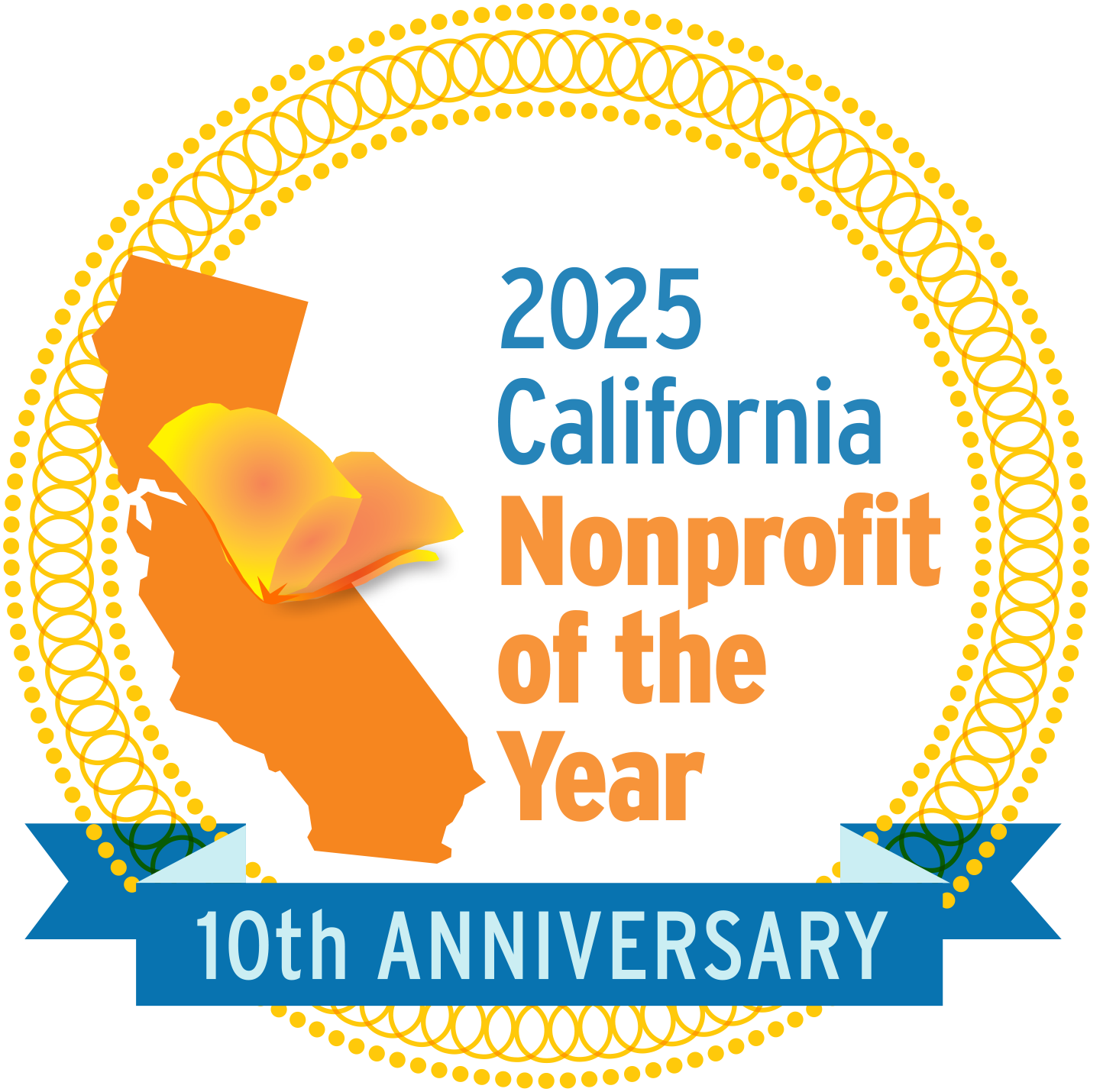Thirteen students trickled into a classroom from the yard — blacks, Latinos, whites, Asians, old and young. They took their seats, and opened their textbooks, and U.S. history class began.
‘What do we mean by civil rights? What are civil rights?’ the instructor asked.
‘The liberty of all civilians,’ said one.
‘The ability to exercise all freedoms under the law,’ said another.
‘Nondiscrimination with regard to race, creed, color, sex,’ said Timothy Nash.
Nash, a tall guy with his dreadlocks pulled back, isn’t a typical college student. For starters, he’s 35 years old. Like all of his classmates, he’s also a convict at San Quentin State Prison. For the past 15 years, he’s been serving out a sentence for charges that add up to 44 years to life.
San Quentin is home to the Prison University Project, the largest on-site college-in-prison program among California state prisons. Inmates in PUP earn their associate’s degree for free, with volunteer instructors from schools like Stanford and UC Berkeley.
Opponents of higher education in prison, like those who voted down a proposal in New York earlier this year, say it’s wrong to give a taxpayer-funded degree to convicts. Some are fine with providing remedial and vocational education, but draw the line at college, a commodity families sacrifice thousands of dollars to give their children.
Advocates see inmate education as a question of helping people stay out of prison once they’re released, and furthermore, of putting communities more at ease about the formerly incarcerated returning to their neighborhoods.
Breaking the cycle
Nothing about Nash, who is from Oakland, would suggest that he killed a person. He spoke of his love of writing, which is why he started at PUP in the first place, and of hobbies, like drawing comic books for kids. At the moment, he was working on one that combined Spongebob Squarepants and football, two of his stepson’s favorite things. He talked about how attending classes had changed his life within San Quentin’s walls and his hopes for the future.
“Being in the class takes me away from just our regular yard associations, so I’m out in the yard with people I wouldn’t have met” if not for class, Nash said. “We had a debate out there last night about how certain presidents have helped or hindered the progress of America.”
Nearly two-thirds of California’s released felons end up back behind bars within three years, according to 2012 data from the California Department of Corrections and Rehabilitation. Inmates who participated in college programs were about half as likely to land back in prison than those who did not, a 2013 study in the Journal of Criminal Justice found.
The higher the level of education a person attains, the less likely they are to go back to prison, studies find. Even if they do return, advocates point out that inmates who receive academic or vocational education cost the system up to $9,700 less, a Rand Corp. study found.
Mostly typical classroom
Tucked behind the baseball diamond in the prison yard, the classroom at San Quentin looked like any learning space: lesson plan on the whiteboard, periodic table on the wall, old TV cart in the back. Light blue uniforms, stamped “CDCR Prisoner” were the only outright reminder that PUP isn’t regular community college.
On this particular day in late July, the lecture covered “The Affluent Society,” the election of John F. Kennedy and the civil rights movement.
On the tables, books were open, some of them filled with Post-it notes to mark pages and passages. Not a student was distracted by a cell phone or a laptop, and none slept through class.
Nash listened from the front row. He’s taken classes through PUP for about two years, since he transferred to San Quentin. He got his GED at the prison in Corcoran, but ran out of options: any college classes he could have taken cost money he didn’t have, he said.
Many inmates request a transfer to San Quentin for its college program, which they often learn about through word of mouth, said Jody Lewen, the program’s executive director.
There are about 330 men in the Prison University Project at San Quentin, and around 400 on its waiting list. About 90 percent of the men who enroll in the program aren’t ready for college, so they start in prep classes. Other than that, any inmate who is eligible to transfer to San Quentin can study with PUP, Lewen said.
Opportunities to grow
Each inmate has his own reasons for enrolling in PUP: Some genuinely want to go to college or factor in that parole boards look favorably on self-improvement. Others have confessed that they started coming to classes because some of the instructors were pretty women.
Lewen said their motives don’t matter because PUP isn’t for slackers, and many of its students attend class on top of holding down prison jobs. They do their homework — lots of it — in the prison’s study hall or in their cells. Without access to the Internet, most students hand-write their papers, and in lieu of online research, instructors print articles for students to read and cite.
“A lot of people have grown up in very restrictive — culturally or socially — environments where they haven’t been exposed to lots of different communities or cultures or ways of thinking about the world. For them, it’s like oxygen. It makes the world so much bigger,” Lewen said.
“I love learning. I really love learning. All I watch on TV is PBS,” Nash said. “It wasn’t that I didn’t like learning when I was in Oakland, it was just that circumstances took me away from school.”
Now, he said school takes him away from prison.
Fewer college programs
Until 1994, when tough-on-crime attitudes wiped out grants that funded college in prisons, many prisons offered higher education. In 1968, a study found that 75 percent of the prison systems it surveyed in the U.S. offered college courses.
Now, up to 42 percent of U.S. prisons offer post-secondary education, but for many inmates, correspondence courses, for which funding can be scarce, are the only option, according to a report by the Institute for Higher Education Policy. Some federal grants are available to inmates under 35 years of age who are within seven years of release and who haven’t committed a list of specific crimes, including murder. But a lot of San Quentin’s inmates don’t fit that bill.
The college program at San Quentin got its start in 1996 with volunteer teachers, just as classes at other prisons shut down. It had no budget. The Prison University Project was formally founded as its own nonprofit in 2006. Its degrees are awarded through Patten University in Oakland.
PUP is now funded through donations from foundations and individuals. While that presents the need to fund raise to provide textbooks and school supplies, it also provides insulation from the politics of funding prison education.
Volunteer instructors
PUP has more than 120 volunteers. Many instructors had never met an incarcerated person before they started teaching at San Quentin, and they are asked not to teach differently than they would in the hallowed halls of their traditional institutions.
“There’s this sort of running joke at the Prison University Project that it’s actually much easier to teach at San Quentin than it is to teach undergrads who are on their phone, or who might complain and haggle over grades a little more,” said Jake Martín Grumbach, a doctoral student at UC Berkeley who teaches American history at San Quentin.
His favorite anecdote is about a time he saw two inmates arguing in the yard.
“I thought it was a stereotypical prison-yard beef, but they turned out to be arguing about who was going to be the valedictorian this year,” he said.
In her time at PUP, Lewen has seen a steady stream of graduates get out of prison and on with their lives. Quite a few are at San Francisco State University, continuing their educations. Others work as electricians and truck drivers, or are back in their communities doing social work, violence prevention and gang intervention.
No cakewalk
One of them is Pat Mims. Now 52, he spent 20 years in prison for second-degree murder. Now out for more than five years, he stopped to chat during a break from his work representing Contra Costa County’s re-entry network at a community fair.
“Prison doesn’t define the person. Prison is a circumstance of bad decisions that a person has made,” Mims said. There “are a number of people in prison who are ready to come out here and be productive, law abiding, taxpaying citizens.”
Mims is from Berkeley, where he started running away from home when he was 13.
“The streets raised me and I became part of the criminal element, and that’s how I ended up in prison, through a long history of drug abuse, of accepting a culture that was not healthy, that was not productive, and not understanding why I was in that culture,” he said.
When he got out of San Quentin, Mims worked to develop a program to combat human trafficking with Bay Area Women Against Rape. He was given a community leadership award for his service.
This year, Mims began a new job as a field operations coordinator at the Reentry Network for Returning Citizens in Contra Costa County, where he works to help former inmates readjust to life on the outside.
He has a small office at the Concord Police Department.
“I find that ironic — after all these years of being against the law, I now work side-by-side, so to speak, with law enforcement to help guys acclimate back into society. It’s a big turnaround for me.”
It’s not always a cakewalk, Mims said.
“There are a number of guys who are going to have a hard time. It’s hard out here. I’ve just been fortunate enough to be in the right arenas at the right time and be able to take advantage of it,” he said.
College as privilege
Today, Mims is balancing family life with work and school. He’s getting good grades toward a bachelor’s degree in sociology at San Francisco State University. Being in class with students so much younger was an adjustment, but he said with his experience, he brings a good argument to class.
“I look at some of the students that don’t understand the privilege that they’re getting, they’re just basically going through the routine of after high school, you go to college. The students inside (prison) are, ‘Man, this is great. This is school — this is college. I’m doing it. (It’s) a dream that was lost at one time,” he said.
That opportunity, and the fact that professors spend hours volunteering to teach them, makes a world of difference to many inmates, Lewen said. Even for those who may never get out, being in the classroom is humanizing. Some inmates say it’s the first time they felt like anybody in prison cared about them.
Expansion possibilities
Lewen and her staff frequently talk about expanding PUP — she’d love to bring it to other prisons in California that are close to colleges and universities, but her first duty is to keep things going at San Quentin, she said.
A professor at Cal State Fullerton is working to bring something like PUP to prisons in the Los Angeles area. And in September, California passed a law that allows community colleges to receive full funding for instruction offered on-site in state correctional facilities, said Millicent Tidwell, the director of the correctional department’s division of rehabilitative programs. With the new law, she hopes to see opportunities for college in prison expand. The California Department of Corrections now partners with 27 colleges to offer education in prisons, but most of the classes are taught by correspondence or video lectures.
“We already have people knocking on our doors to open up opportunities, so we’re going to be working on an expansion effort,” Tidwell said.
At the end of 2012, 1 in 35 adults in the U.S. was incarcerated, on probation or parole, according to the Bureau of Justice Statistics.
“When you oppose education inside, you’re opposing guys and women (having) the opportunity to learn, the opportunity to grow, the opportunity to expand their knowledge in a way that can change their way of thinking and behavior,” Mims said. “Education does that for all of us. If you can provide it inside, you have an opportunity of a better person coming back out.”
Positive role models
If Timothy Nash gets out of San Quentin, he wants to work in advocacy.
“I want to start youth programs because I don’t want a lot of people to follow in my footsteps. I didn’t have a mentor. I didn’t have the guidance I needed, so I want to be able to use not only my education but my understanding of their side of the story,” he said.
Part of what he said drives him to keep studying is his son.
“He’s in jail right now, because of my absence,” he said. “I don’t want to tell my son, ‘Well, you need to get an education, you need to do this,’ when I didn’t do it myself. So I want to be a positive role model for my son.”
Attribution: This originally appeared in SFGate on December 26, 2014.
Read Story
Please note that the Prison University Project became Mount Tamalpais College in September 2020.
